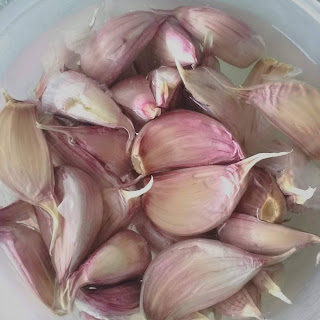I decided I was going to use some of my distilled pickling vinegar to pickle some garlic. The various articles about it online implied it was a very easy process- and that a jar of pickled garlic is very useful to have in the cupboard. You can use the cloves in recipes calling for fresh garlic -and it is convenient to have them already peeled. I bought a handful of plump bulbs from the supermarket and assembled everything in the kitchen.
Ingredients; Kettle, vinegar, garlic, some mustard seeds, and some saffron strands.
Equipment; Sieve, jug, saucepan, sterilised kilner jar, spoon.
First you need to remove the papery skins. Separate the cloves, put them in a jug, cover with boiling water. Leave for 90 seconds.
 Now tip them into a sieve and run under the cold tap to cool. You will not believe how easily the skins rub off. They looked so pretty, like delicate pink flower petals,
Now tip them into a sieve and run under the cold tap to cool. You will not believe how easily the skins rub off. They looked so pretty, like delicate pink flower petals,  but I had to put them in the food waste as I couldn't think of a use for them. Put the vinegar in the pan and bring to the boil.
but I had to put them in the food waste as I couldn't think of a use for them. Put the vinegar in the pan and bring to the boil.Put I tsp mustard seeds into a jar, with a few saffron strands. Drop in the pristine white cloves. Pour over the boiling vinegar, seal the jar, and wait...
And that's it. The saffron strands should tint the liquid a pale golden hue and the mustard add a little spice to the final result. I felt so pleased. This cost the fraction of a ready made jar from the shop, and I made this in the time it took to listen to The Archers. Later in the evening we went into the kitchen to make a cuppa. And my garlic had gone BLUE. An alarming bluey green shade. Oh no!!
Bob opened the lid- some cloves at the top, barely submerged in the pale yellow liquid, were a delicate Tiffany blue colour. I love Tiffany blue BUT NOT IN MY GARLIC!!
What a waste, what went wrong, do you think? Bob, ever resourceful, googled "Why is my pickled garlic blue?"
And yes, blue/green garlic is a 'thing'. There is nothing at all to worry about. Science bit...when you cut or crush garlic, you create an organosulphate compound called allicin. This is what gives garlic its odour and flavour. When the garlic meets an acid [like vinegar] the allicin reacts with the amino acids in the garlic to form rings of carbon-nitrogen called pyrrholes. The phyrroles link to form POLY-pyrrholes which create colours. Three clustered together make blue, four clustered make green [hence chlorophyll is green]
It is all perfectly safe, perfectly edible, so do not fret. In fact, at Chinese New Year, the jade-green laba-garlic is greatly prized, considered beautiful and healthy. I guess it won't be noticeable when the garlic is inside a stew or sauce - but I am a little miffed that none of the recipes I read beforehand actually mentioned this possible side effect! [To be fair, the Sarson's recipe uses malt vinegar, and I guess the blue/green tinge wouldn't show up] Blue garlic - who knew?




Oooh, I like the tip with the boiled water. Composting is still a good thing to do with the skins so fret not! Blue Garlic though...x
ReplyDelete